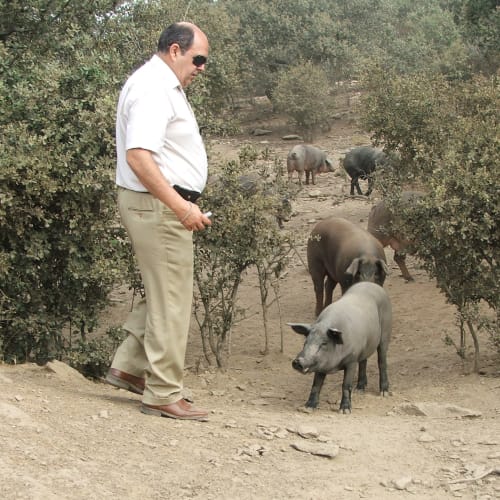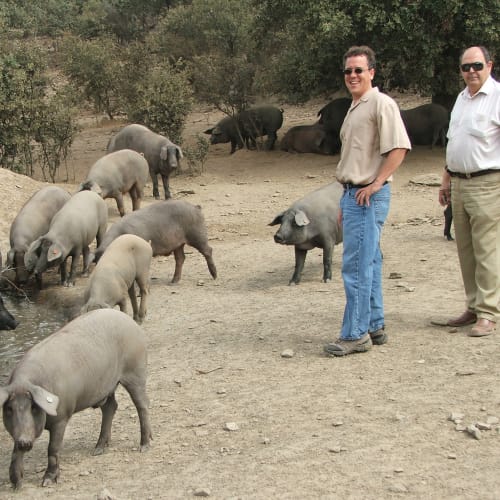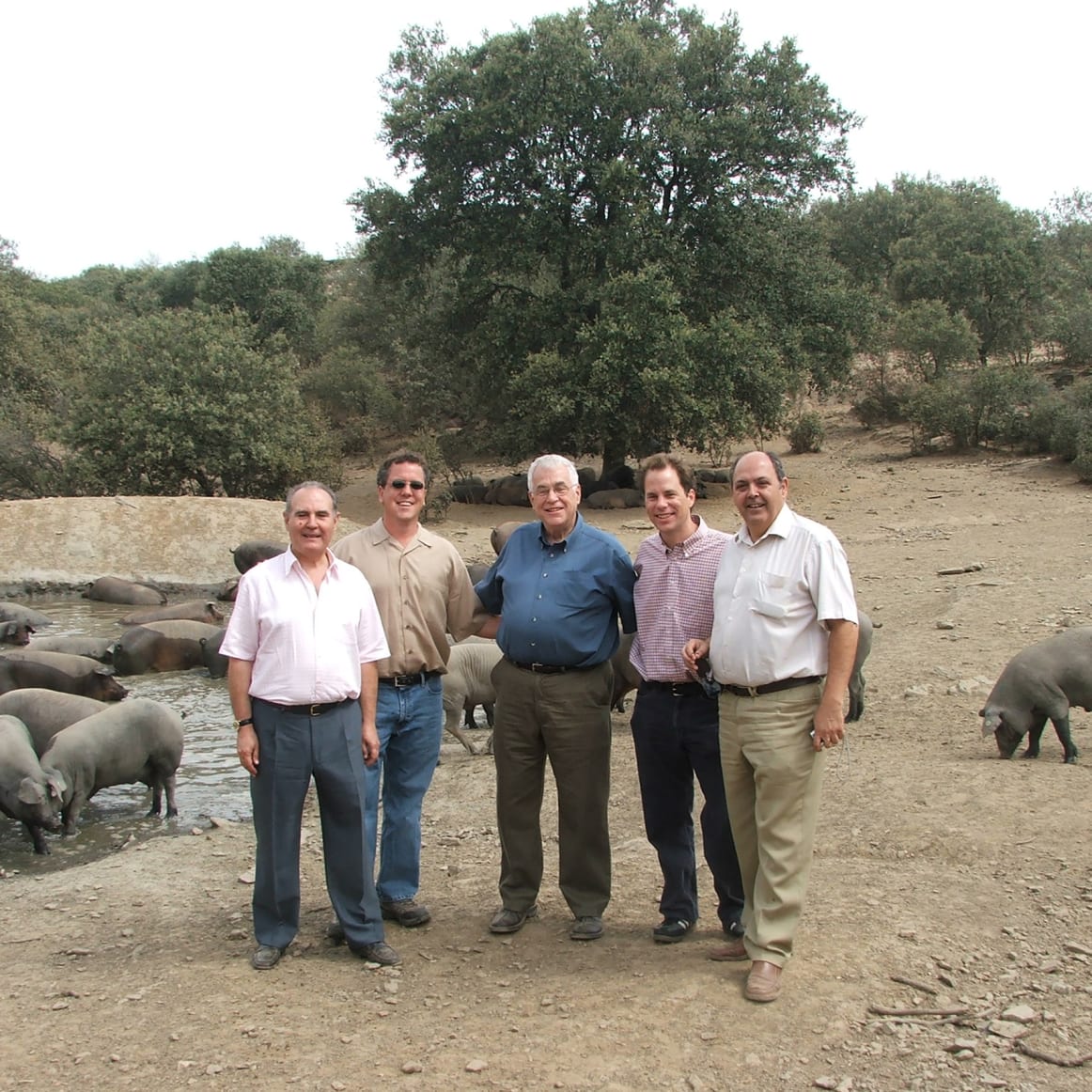Three Kings Sale - Up to 40% Off! Shop Sale
The Professor of Jamón
July 2006




I have enjoyed many personal contacts with Spanish artisans and families over the past ten years of La Tienda -- it is a source of deep satisfaction. Through the bonds my family and I have formed with families throughout the many regions of Spain, we have grown to have a profound respect for the values of the traditional Spanish culture.
Today I would like to introduce you to another remarkable person, Antonio Gázquez Ortíz. He is a man of extraordinary breadth: scholar, author, research scientist, renowned gastronome. He is also a man of depth: a father and a friend with a generous heart. He and his wife Purificación have two adult sons: David, 27, a professor of music and Miguel Angel, 21, a photographer and designer who has a musical group; and three daughters: Puri, 22, a university student; Yia, 21, who is married and Lola, 10, who is in primary school.

Antonio represents the best of Extremadura -- one of the most attractive parts of Spain. I particularly enjoy the village of Trujillo, home of conquistadores, and the shrine of Nuestra Señora de Guadalupe, a favorite of Ferdinand and Isabella.
The region is the home of ranchers and breeders as well as the fabled black-hoofed Iberian pigs -- which have made this land their home for centuries. These animals are the source of the mythical Jamón Ibérico, and provided the impetus for our ten year quest to bring this precious product to the tables of America.
The last ten years have taken our family along many a path throughout these southwestern reaches of Spain. My wife Ruth and I began our family's journey into the realm of the antique black-hoofed Ibérico pigs in 1997. First we made a pilgrimage to the village of Jabugo in western Andalucía, and much later to the Las Pedroches Dehesa pastureland north of Córdoba. In addition, my sons Tim and Jonathan and I have been privileged to meet some of the most famous producers of Jamón Ibérico in Salamanca, including in the ham city of Guijuelo and the rugged mountain village of La Alberca.
But it was when we met Antonio Gázquez in Cáceres that our experiences seemed to coalesce. And what better place to meet him than in ancient and noble Cáceres. The city was founded by the Romans in the 1st Century; it weathered barbarian and Moorish invasions, and then regained its original splendor when the returning Conquistadors built señorial houses within its walls. During all these changes wrought by men, the black-hoofed pigs were minding their business fattening up on delicious acorns from the local cork trees. Perhaps we can learn something from them!
Dr Gázquez's roots are in the soil of Extremadura. It is there that he has devoted his life to unraveling and expounding upon the myth of the Iberian pig -- which has roamed the Iberian Peninsula from the time of the cave men. Holding the chair of Histology (the study of animal tissues) at the University of Extremadura in Cáceres, he has approached these legendary animals in terms of pure scientific analysis, and has inspired many of his students to continue the search for greater understanding of this unique animal.
My sons Tim and Jonathan, friend Jamie and I were traveling through the region in order to learn as much as we could about this "pata negra" black hoofed pig. My friend Peter Kaminsky, a writer for the New York Times, told me of his experience with Antonio while doing research for his fascinating book Pig Perfect. After reading this book I resolved to meet this man about whom Peter spoke so highly, and so by e-mail we made contact with Dr Gázquez. I received an enthusiastic reply from Antonio, in which he suggested that we meet at a venta/café on the outskirts of Cáceres.
When we arrived at the roadside café that morning we were greeted warmly by Antonio and his rancher companion. We got to know one another other a little while enjoying churros and café con leche, and then set out in two vehicles to explore a nearby ranch where Ibérico pigs were being raised. In one car, my sons soon became lost in animated conversation with Antonio about animal husbandry. (He is ever the teacher). My friend Jamie and I were in the other car with the rancher, a cordial and knowledgeable gentleman who told us all that there was to know about the practical concerns of raising these remarkable animals.

After all of us rejoined and met the pigs at a waterhole, it was time for the traditional Spanish mid-day meal. I would not call it a lunch; I would call it a feast. The Spanish know how to "break bread together." As we left the pigs glanced at us with only passing interest -- their feast would come in the autumn when the surrounding acres of cork-oaks would provide them with an abundance of bellotas (acorn treats).
Antonio took us to the medieval section of Cáceres with its narrow streets and stone battlements. Adjacent to the handsome cobble-stoned Plaza de San Juan was Antonio's favorite restaurant, El Figón de Eustaquio. The venerable building, with dark wood paneling, was filled with expectant diners and skilled waiters darting from table to table. As we were ushered to an elegant private dining room in back we passed by the kitchen from which came aromas of roast meat and herbs.
At the dinner table Antonio the professor was transformed into Antonio the gastronome as he presided over a sumptuous feast. Before us were local cheeses, fresh shellfish, wines, and plates of paper-thin sliced Jamón Ibérico which were glistening due to the warmth of the room -- its monounsaturated marbling turns to liquid at 70º F -- truly extraordinary! Always the teacher, this time Antonio was in the role of the gourmet. In a genuine and unassuming way, he was acquainting us with the fine art of enjoying the fruits of the earth.
Antonio Gázquez is a man for all seasons. A genuine enthusiast, he enjoys equally being an author, a gourmet, a scientist and a historian. Most of all, he loves to teach. He has written many scholarly articles and books, some of which are the definitive texts in his field. Three recent books are particularly engaging: Porcus, puerco, cerdo -- a history of the pig in Spanish gastronomy; La cocina in tiempos del Arcipreste de Hita: -- an account of the medieval cuisine of Christians, Jews and Moors; and Conversations with a Gastronome where he reflects on the cuisine of late 20th C.
I was much impressed with the knowledge and grace of this man, so I asked him if he would be willing to write a series of reflections upon Spanish cuisine and especially his greatest love, Jamón Ibérico. Antonio generously consented. He has written two essays and another is on the way. I will post them periodically on our web page, so that you may enjoy them as well. I consider it a great privilege to have such an eminent, yet unassuming gentleman contribute to La Tienda.
Un Abrazo,
Don

